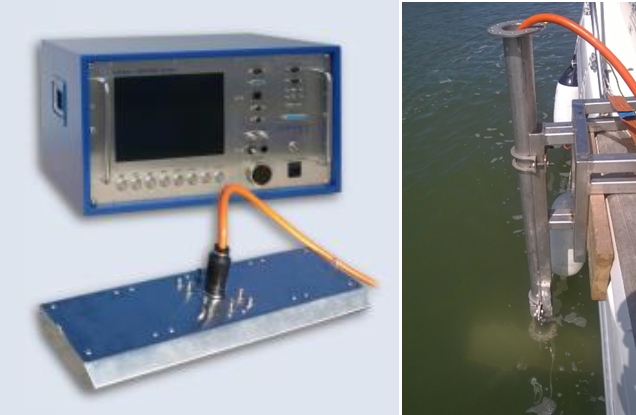22 / 08 / 2016
.jpg)
The structures visible on the echounder image (left) correspond to the (in the 1970s still outcropping) peat extraction traces on the beach of Raversijde (right). Photo: Tine Magill (left) and E. Cools (right).
The echosounder, type SES-2000 Quattro, was recently developed by the German technology company Innomar. The narrow-beam sub-bottom profiler can be used to visualise sediment structures in geological surveys and to localise embedded objects like wrecks or archeologic remains, all with an excellent resolution and penetration. This instrument can be used in several marine research lines like archaeology, sedimentology, geology, building technology, hydrodynamic, geotechnology and ecology.
In May 2015, a borrowed demo version of the device was used in a very successful test measurement carried out in shallow coastal waters near Raversijde (Belgium), where old peat excavation from Roman times - now buried under the sand - could be visualized with a dazzling detail (see photo). Also a partially buried wooden ship wreck in the port mouth of Ostend and buried objects in the port of Ostend were explored. More details about these first explorations can be read on the SeArch website.
After this very positive test, the Flanders Marine Institute (VLIZ) decided to purchase its own SES-2000 Quattro in January 2016, financed with the annual investment budget for equipment. In April 2016 a workshop was organized in Ostend for a dozen of interested users from various universities, marine industry (DEME, Jan De Nul), the Belgian Navy, and the national cultural heritage organization of The Netherlands.
In September 2016 new measurements are scheduled within the SeArch project to investigate into what extent drowned remains of the medieval Oostende and Walraversyde are still visible. Between the 14th and the 16th century the southern North Sea coast was the subject to repeatedly disastrous storms. Large tracts of the coastal town of Ostend and the fishing village of Walraversyde drowned and were rebuilded more inland. The measuring campaign of September wants to investigate to what extent some relics of Oostende and Walraversijde are preserved under the seabed, and how they can inform us as a witness about the long term problems of relative sea-level rise.
As it applies for all equipment and research infrastructure of the Flanders Marine Institute (VLIZ), the new multi-transducer echosounder is put at the disposal of the Flemish and international community of marine researchers. The use of this specific equipment however is always linked with the supervision of a marine technician from VLIZ. The echosounder can be deployed from aboard the RV Simon Stevin or from smaller vessels. In case of interest, contact André Cattrijsse for more information.

Multi-transducer and seismic acquisition unit (left). Multi-transducer pole attached to the side of the vessel (right). Photo: Innomar (left) en Tine Missiaen (right).